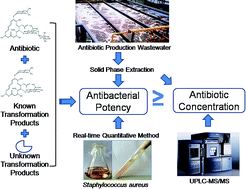Evaluation of residual antibacterial potency in antibiotic production wastewater using a real-time quantitative method†
Abstract
While antibiotic pollution has attracted considerable attention due to its potential in promoting the dissemination of antibiotic resistance genes in the environment, the antibiotic activity of their related substances has been neglected, which may underestimate the environmental impacts of antibiotic wastewater discharge. In this study, a real-time quantitative approach was established to evaluate the residual antibacterial potency of antibiotics and related substances in antibiotic production wastewater (APW) by comparing the growth of a standard bacterial strain (Staphylococcus aureus) in tested water samples with a standard reference substance (e.g. oxytetracycline). Antibiotic equivalent quantity (EQ) was used to express antibacterial potency, which made it possible to assess the contribution of each compound to the antibiotic activity in APW. The real-time quantitative method showed better repeatability (Relative Standard Deviation, RSD 1.08%) compared with the conventional fixed growth time method (RSD 5.62–11.29%). And its quantification limits ranged from 0.20 to 24.00 μg L−1, depending on the antibiotic. We applied the developed method to analyze the residual potency of water samples from four APW treatment systems, and confirmed a significant contribution from antibiotic transformation products to potent antibacterial activity. Specifically, neospiramycin, a major transformation product of spiramycin, was found to contribute 13.15–22.89% of residual potency in spiramycin production wastewater. In addition, some unknown related substances with antimicrobial activity were indicated in the effluent. This developed approach will be effective for the management of antibacterial potency discharge from antibiotic wastewater and other waste streams.


 Please wait while we load your content...
Please wait while we load your content...